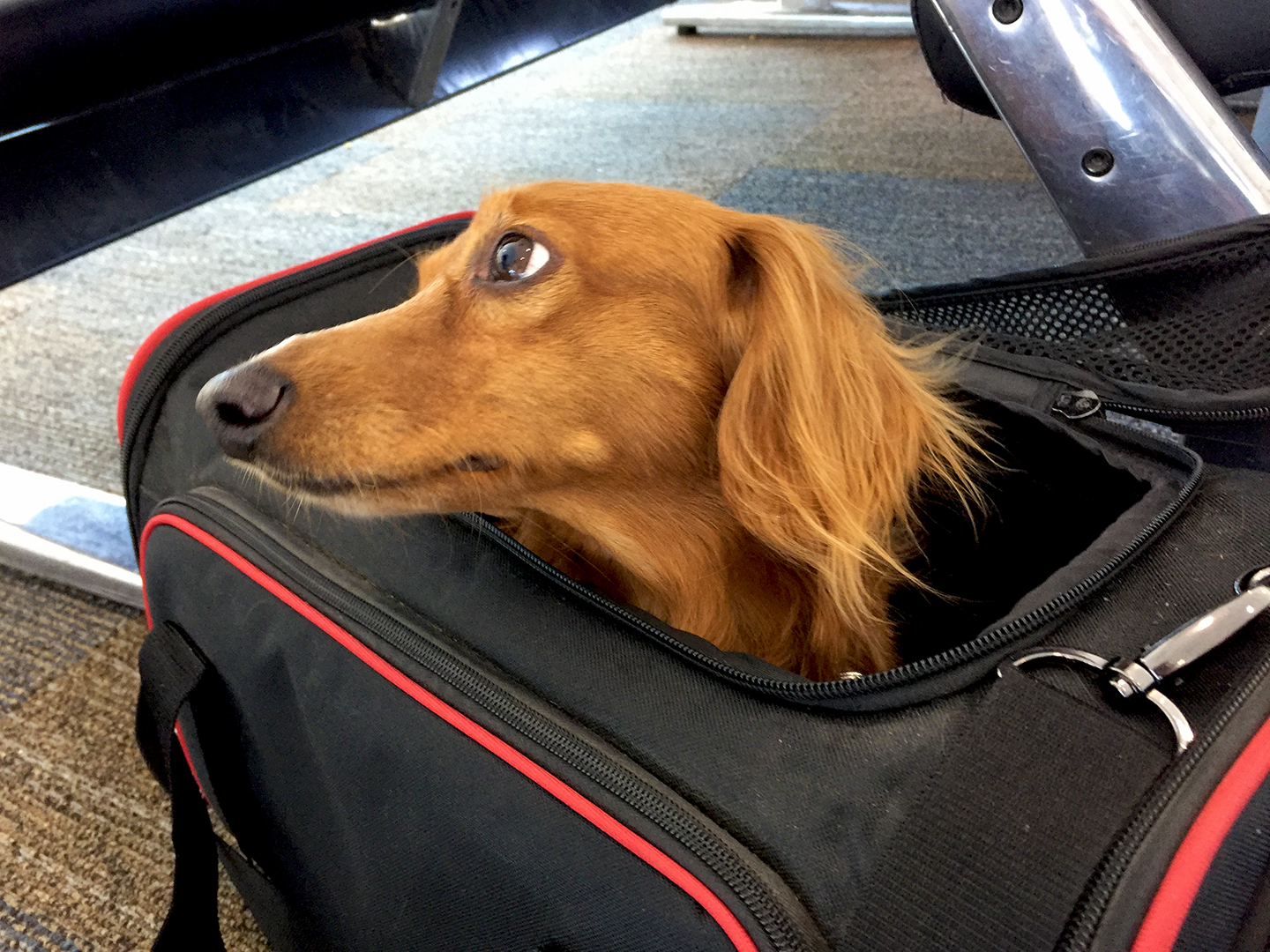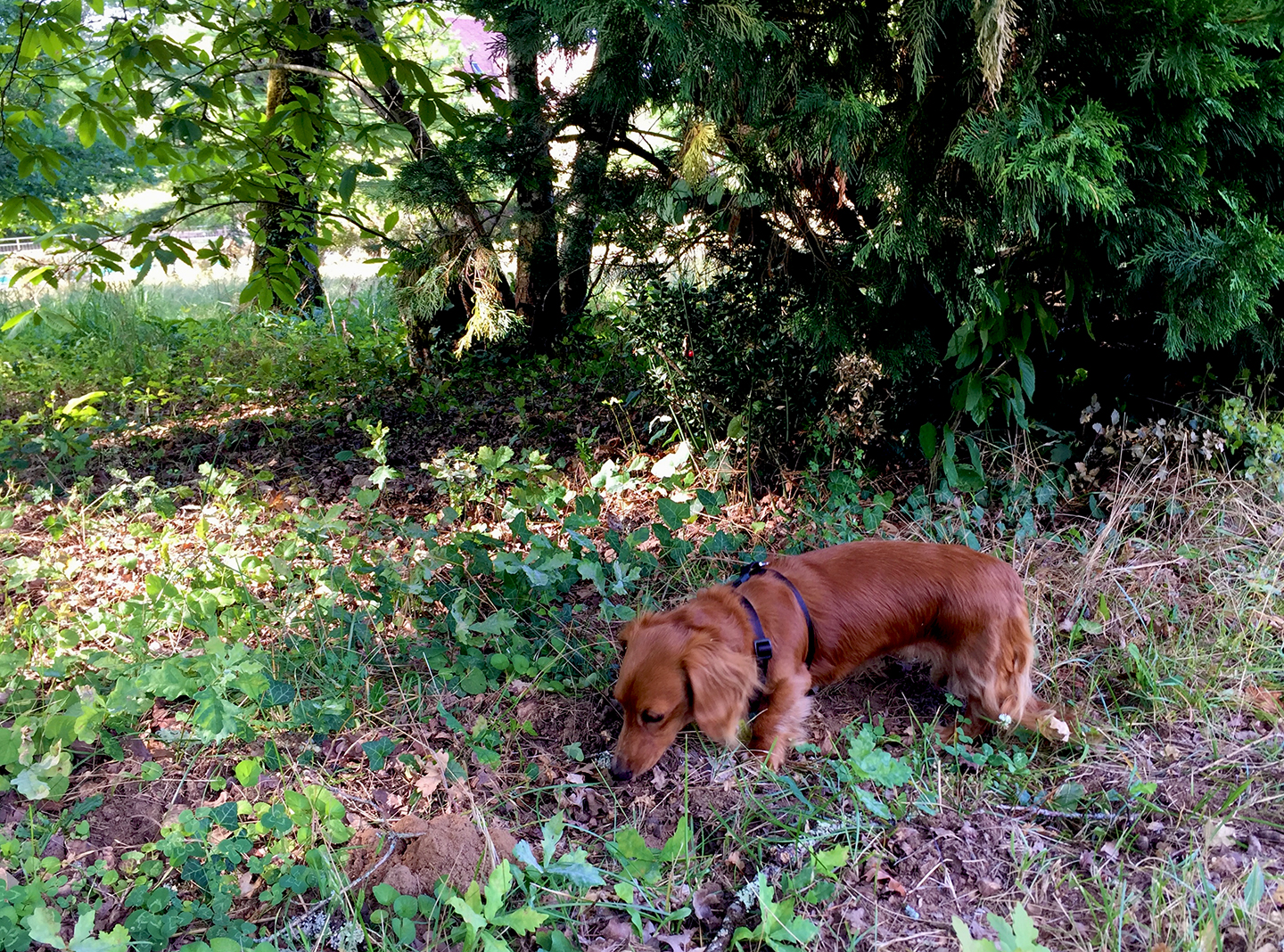I confess that I felt some anxiety about flying with our dog as we were relocating to France. Lily was never much of a traveler: for starter, she would routinely get car sick after a twenty-minute ride. Our ace in the hole was that she was used to sleeping in her crate and had no issue with being confined overnight. Her small size gave us the option of flying her in the cabin with us but I was still concerned about her spending some twelve hours enclosed in her carrier. All pets have different personalities but I thought I would share our experience about Lily’s Excellent Adventure and about her new life in France: other humans might glean some insight to make their four-legged companion’s travel less stressful.
Are we there yet? My uncles Rick and Jim gave us a ride to the airport in their motorhome. Loved it!
1/ First things first: not all airlines accept pets in cabin (or in cargo, for that matter) so check airline websites for their pet travel policies. Those that do allow pets in cabins limit the number of animals on a given flight. Except for service or emotional support animals, your pet will be confined in his carrier for the duration for the flight, and the carrier must fit under the seat in front of you (that pretty much nixes flying Business Class outfitted with a lie-flat seat.) And yes, the carrier counts toward your luggage allowance. Find out the maximum dimensions of the allowable carrier and train your pet to spend time in it. In our case, we switched Lily from her “spacious” hard crate to the much smaller soft carrier four months before departure, hiding treats inside to motivate her to explore her new digs and feel more at home.
Oooh! Lots of new scents at the farm!
2/ Book your flight several months ahead with an airline rep. Websites will not tell you whether the “animal quota” for a given flight has been reached. I wanted to use United Airlines miles for our flight. I checked online for award availability around our desired departure date; then I called their reservation center to inquire about having a pet in cabin on my preferred itinerary and confirmed that we could bring Lily with us; I booked our flights and asked the rep to add Lily to my reservation ($125 extra.) I printed my ticket receipt and made sure the “pet in cabin” was listed on it.
A mole hill! First, dispatch the dirt; then, sink the nose into the hole.
3/ Several health documents need to be filled and verified before your pet can fly with you and the requirement vary with origin and destination. Stacie, a Facebook friend who regularly flies to France with her compagnon à quatre pattes, shared many helpful pointers. Do not assume that your veterinarian is well-versed on that topic: do your own research on the government pages of the country you will be visiting. Regulations and forms are complex. I strongly encourage you to visit the Pet Travel Store and to order the appropriate forms from them: they will be tailored to your destination and pet species.
I just know there is a mouse hiding between these logs.
4/ Make sure that your vet is accredited by the USDA: our regular vet was on maternity leave and her substitute was not USDA accredited: we had to make an appointment at another veterinary clinic. Your pet must be implanted with an ISO 15-digit non-encrypted microchip. EU authorities will not be able to read other styles of microchips: you’ll either need to have the “correct” microchip inserted by your vet or rent/purchase your own microchip reader. A microchip certificate must be filled by the vet. Your pet must be vaccinated for rabies at least 21 days prior to entry and the vet must fill out the EU Veterinary Certificate from France (7 pages) not more than 12 days prior to your travel date. IN BLUE INK (I don’t know why but I’ve learned to never question bureaucracy…) Then, the certificate must be taken (or mailed) to your USDA/APHIS/US Area Office, along with a check for $38, for certification; use Express Mail both ways as you will need the certification to fly out. You also must complete a Declaration of Non-Commercial Movement. Additionally, most airlines require a Veterinary Certificate for Domestic and International Airline Travel where you vet states that your pet is healthy enough to travel, is free of parasites, shows no evidence of diseases communicable to humans, and has a valid vaccination against rabies.
I’ll just watch my territory from the front door. And work on my tan.
5/ All these forms constitute the “Pet Passport” and must be presented when you check in for your flight. It’s a good idea to have a set of copies with you as some airlines will want to retain the information and check-in counters do not usually have a copy machine nearby. The originals stay with you for entry into France.
My new cousins are cool. Aunt Françoise also keeps two cats and one hen. I’m not too fond of them; I like to chase them but that big chicken is a bit scary.
To make sure that Lily met all requirements, I booked our flights four months in advance, ordered the forms from PetpassportStore.com, contacted my vet to make sure the microchip was the 15-digit style, scheduled an appointment 10 days prior to our departure (we spent two solid hours at the vet’s office: they’re just not familiar with the forms and requirements) and sent Rick to the USDA office in Sacramento the same day. Just to be on the safe side, I asked our vet to prescribe some Cerenia, an anti-nausea drug, that we gave her before the car and plane travels. We also had a mild sedative on hand in case she got too agitated in the plane but we didn’t use it.
Where is this delicious French food I keep hearing about?
To make the trip easier on our little girl, we decided to break the journey in three chunks so she wouldn’t be confined for the equivalent of a day and a half: I booked a pet-friendly hotel at SFO airport where we spent the night before the flight and I also reserved a pet-friendly hotel near Orleans for the day of our arrival. Besides, I just couldn’t imagine driving all the way down to Gourdon right after landing at CDG…
After a nice Sunday lunch, I got to nap in the hammock with Cousin Brice.
Documents were thoroughly reviewed by the airline rep when we checked in but les douaniers didn’t bat an eye when we arrived in Paris. We were pleasantly surprised by Lily’s demeanor throughout the trip in spite of a flight delay of three and half hour: she made friends with several passengers at the gate who turned out to be seated in the row in front of us. Kudos to the crew on our United Airlines flight: they encouraged us to get her out of her carrier and to hold her on our laps for takeoff and landing. They also offered to give her some water. Well, I didn’t want to tempt fate and watched her water intake like a hawk but Lily is blessed to have a bladder of steel! The long car ride went smoothly as well. I was a proud mama.
Mom says I still need to work on my table manners.
This whole experience transformed our dog into an enthusiastic traveler: she even hops into the car with Rick when he’s taking garbage to the dump. She has adjusted to her new life very quickly. Most people think of dachshunds as lap dogs but they were actually bred to hunt badgers and Lily would make her ancestors very proud: she actively patrols her territory and sniffs out taupes, hérissons et lézards. She even caught une souris ! She’s great with the neighbors’ dogs, not so much with their cats. I think she was really meant to lead an active country life. She is active, happy, and enthusiastic. We’ll just need to enroll her in “finishing school” so she can become one of those well-behaved French dogs who patiently seat under a café table while her humans enjoy a beer en terrace…
Vocabulary
Un compagnon à quatre pattes: four-legged companion
Le douanier: customs officer
La taupe: mole
Le hérisson: hedgehog
La souris: mouse
En terrace: outdoors
IMPORTANT. The informations supplied above applied to our specific situation: flying from the US to France with one dog in July 2018. Requirements can vary depending on several factors such as pet species, number of animals traveling, country of origin, destination, stopovers, etc.










